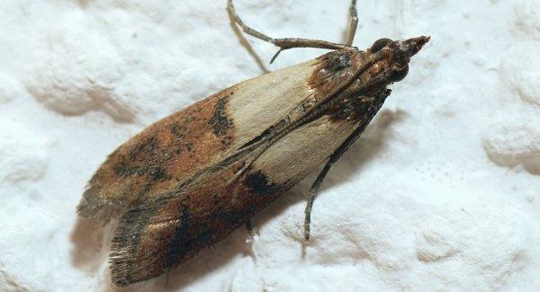The northeastern United States is famous for a great many things. One of those things, unfortunately, is the Indian meal moth. The Indian meal moth is one of the more common species of moths, particularly in the northeastern part of the United States. Sometimes called pantry moths, these moths have a wingspan of nearly three-quarters of an inch long, are copper in color, and tend to fly somewhat erratically in a zig-zag pattern.
They’re in My Kitchen!
Indian meal moths come in through open windows or doors in the warmer months or hitch a ride in your grocery bags from the store and immediately get to work trying to find food sources. These moths seek out grain products, fruits, and processed foods that are usually found in the pantry and not in the refrigerator, hence the nickname.
The first step to ridding yourself of these nasty buggers is tossing out anything that may have been contaminated by the moths. They tend to lay eggs in food sources such as flour and cereals. When you replenish your stock, try to store the new supplies in tightly sealed containers.
What?! I Have to Throw Away My Food?!
It will be in your best interest to get rid of anything that has been exposed to Indian meal moths. No one wants to finish a meal only to realize that the food was infested with Indian meal moth larvae! You might want to bite the bullet and toss anything in the pantry that might have been exposed. Anything in air-tight containers or cans should be fine to stay, but the cereals, boxed goods, and fruit should go. When you restock your shelves, invest in glass or plastic containers with lids.
How to Prevent Future Indian Meal Moth Problems
Beyond keeping your windows and doors closed up tight all year long, which nobody wants to do, you can buy some good screens. Mesh screens will keep almost all pests out of your home, including Indian meal moths. And caulk up cracks and crevices around doors and windows to seal tiny openings.
When you’re doing your grocery shopping, make sure you examine all the dry goods you’re buying thoroughly. Look for the familiar signs of pantry moths like rips in cardboard or holes in paper bags. The items you buy from the store may be already infested with meal moths or their larvae if the packages have holes.
That Might Not Be Enough - Get Professional Indian Meal Moth Removal
Simply closing your doors and windows and tossing out food that could have been contaminated might not get rid of an Indian meal moth infestation entirely. You may need professional help to make sure your family is safe. The experts at Big Blue Bug Solutions will be happy to professionally treat your home to fully exterminate these moths. You and your family shouldn’t have to worry about the food you want to eat out of your own pantry!

